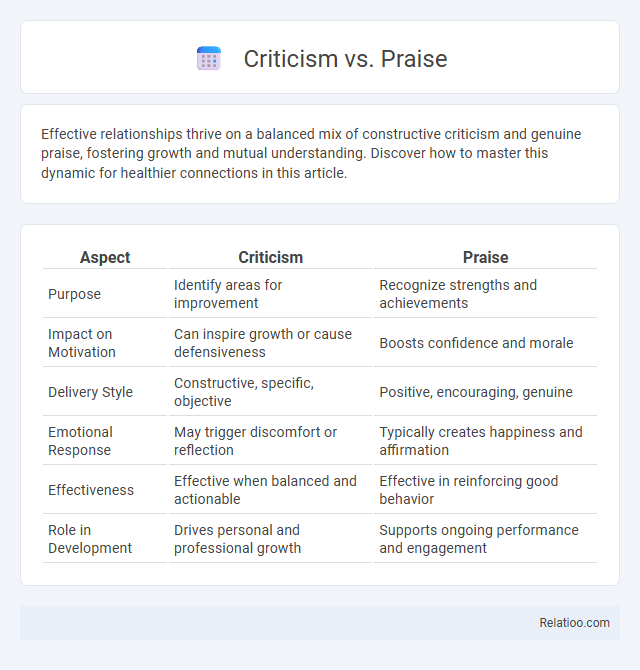Effective relationships thrive on a balanced mix of constructive criticism and genuine praise, fostering growth and mutual understanding. Discover how to master this dynamic for healthier connections in this article.
Table of Comparison
| Aspect | Criticism | Praise |
|---|---|---|
| Purpose | Identify areas for improvement | Recognize strengths and achievements |
| Impact on Motivation | Can inspire growth or cause defensiveness | Boosts confidence and morale |
| Delivery Style | Constructive, specific, objective | Positive, encouraging, genuine |
| Emotional Response | May trigger discomfort or reflection | Typically creates happiness and affirmation |
| Effectiveness | Effective when balanced and actionable | Effective in reinforcing good behavior |
| Role in Development | Drives personal and professional growth | Supports ongoing performance and engagement |
Understanding Criticism and Praise
Understanding criticism and praise involves recognizing their distinct psychological impacts on motivation and self-perception. Criticism, when constructive, targets specific behaviors and encourages growth, while praise reinforces positive actions and boosts confidence, fostering a growth mindset. Neuroscientific studies show that balanced feedback combining both elements optimizes learning and emotional resilience.
The Psychological Impact of Criticism
Criticism significantly affects emotional well-being by activating brain regions linked to pain and stress, often leading to decreased self-esteem and motivation. The negativity bias intensifies these effects by making individuals more sensitive to negative feedback than praise, which can overshadow positive affirmations. Understanding the psychological impact of criticism helps in developing strategies to foster resilience and promote constructive feedback in personal and professional environments.
The Power of Praise in Motivation
Praise activates the brain's reward system, releasing dopamine that enhances motivation and reinforces positive behavior. Studies reveal that targeted, specific praise improves performance and fosters resilience more effectively than general or vague compliments. Unlike negativity bias, which prioritizes negative feedback, the strategic use of praise cultivates a constructive environment conducive to growth and sustained engagement.
Constructive Criticism vs Destructive Criticism
Constructive criticism offers actionable feedback aimed at improvement, helping you grow by highlighting specific areas for development while maintaining a supportive tone. In contrast, destructive criticism focuses on fault-finding without solutions, often leading to discouragement and a negative impact on motivation. Understanding the difference between these types of feedback can help you filter negativity bias and use praise and critique effectively for personal or professional growth.
When to Offer Criticism or Praise
Offering criticism is most effective when your goal is to improve specific behaviors or outcomes, preferably in a private setting to reduce defensiveness. Praise should be given to reinforce positive actions, boosting motivation and reinforcing desired habits in both professional and personal contexts. Your awareness of negativity bias helps balance feedback, ensuring constructive criticism does not overshadow genuine recognition of achievements.
Cultural Perspectives on Criticism and Praise
Cultural perspectives on criticism and praise reveal distinct approaches to feedback, where Western cultures often value direct criticism for improvement, while Eastern cultures emphasize indirect feedback to maintain harmony. Praise in collectivist societies tends to be modest and group-focused, contrasting with individualistic cultures that encourage public recognition of personal achievements. Understanding these cultural nuances is crucial for effective communication and leadership in multicultural environments.
Common Misconceptions About Praise
Common misconceptions about praise include the belief that excessive praise always boosts self-esteem and motivation, which can lead to dependency on external validation. Research indicates that indiscriminate or insincere praise may undermine intrinsic motivation and hinder personal growth. Effective praise is specific, sincere, and focused on effort or skill development rather than innate ability to foster resilience and a growth mindset.
Balancing Criticism and Praise for Growth
Balancing criticism and praise is essential for fostering personal and professional growth, as excessive negativity bias can hinder motivation and self-esteem. Constructive criticism provides actionable feedback that promotes improvement, while genuine praise reinforces positive behaviors and achievements, encouraging continued effort. Cultivating an environment where feedback is balanced helps individuals develop resilience, self-awareness, and a growth mindset.
How to Receive Criticism and Praise Effectively
Receiving criticism effectively involves active listening, focusing on specific feedback rather than taking it personally, and using it as an opportunity for growth. Embracing praise requires acknowledging achievements without letting it foster complacency, reinforcing motivation, and maintaining humility. Understanding negativity bias helps balance the impact of negative comments by consciously valuing positive feedback and fostering a constructive mindset.
Tools for Giving Effective Feedback
Effective feedback tools emphasize a balance between criticism and praise to counteract negativity bias, which often leads individuals to focus more on negative input. You can use specific techniques like the "sandwich method," where constructive criticism is framed between positive comments, or employ clear, actionable language to ensure your feedback is both motivating and helpful. Incorporating regular, genuine praise fosters a positive environment, making critiques easier to accept and more impactful.

Infographic: Criticism vs Praise
 relatioo.com
relatioo.com